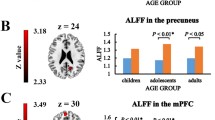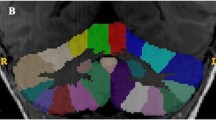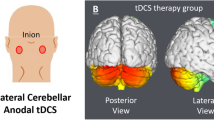Abstract
Autism spectrum disorder (ASD) is a neurodevelopmental disorder. The associations between the cerebellum and clinical traits remain unclear. We performed amplitude of low-frequency fluctuation (ALFF) analysis to explore the associations between spontaneous brain activity and clinical traits. 361 juvenile ASD patients were included from the ABIDEII database. In the ASD group, the mean ALFF values of cerebellum 4 5 were correlated with SRS awareness and communication. The mean ALFF values of cerebellum 6 and vermis 4 5 were both positively correlated with SRS total, awareness, communication, and motivation. In contrast, the mean ALFF values of vermis 1 2 were negatively correlated with SRS total, awareness, and mannerisms. Our study suggests a role of the cerebellum in functional impairments in ASD.


Similar content being viewed by others
Data Availability
The data used are publicly available in the ABIDE II database (http://fcon_1000.projects.nitrc.org/indi/abide/abide_II.html). The IDs of the subjects used in the study are listed in Appendix 1.
Abbreviations
- ASD:
-
Autism spectrum disorder
- ALFF:
-
Amplitude of low-frequency fluctuations
- ReHo:
-
Regional homogeneity
- fMRI:
-
Functional magnetic resonance imaging
- ROI:
-
Region of interest
- SRS:
-
Social responsiveness scale
- FC:
-
Functional connectivity
- AAL3:
-
Automated anatomical labelling 3
References
Aldinger, K. A., Kogan, J., Kimonis, V., Fernandez, B., Horn, D., Klopocki, E., Chung, B., Toutain, A., Weksberg, R., Millen, K. J., Barkovich, A. J., & Dobyns, W. B. (2013). Cerebellar and posterior fossa malformations in patients with autism-associated chromosome 22q13 terminal deletion. American Journal of Medical Genetics. Part A, 161A, 131–136.
Argyropoulos, G. P. D., van Dun, K., Adamaszek, M., Leggio, M., Manto, M., Masciullo, M., Molinari, M., Stoodley, C. J., Van Overwalle, F., Ivry, R. B., & Schmahmann, J. D. (2020). The cerebellar cognitive affective/schmahmann syndrome: A task force paper. Cerebellum, 19, 102–125.
Association, A. P. (2013). Diagnostic and statistical manual of mental disorders, fifth edition (DSM-5). American Psychiatric Publishing.
Bai, D., Yip, B. H., Windham, G. C., Sourander, A., Francis, R., Yoffe, R., Glasson, E., Mahjani, B., Suominen, A., Leonard, H., Gissler, M., Buxbaum, J. D., Wong, K., Schendel, D., Kodesh, A., Breshnahan, M., Levine, S. Z., Parner, E. T., Hansen, S. N., … Sandin, S. (2019). Association of genetic and environmental factors with autism in a 5-country cohort. JAMA Psychiatry. https://doi.org/10.1001/jamapsychiatry.2019.141
Bostan, A. C., Dum, R. P., & Strick, P. L. (2013). Cerebellar networks with the cerebral cortex and basal ganglia. Trends in Cognitive Sciences, 17, 241–254.
Buckner, R. L. (2013). The cerebellum and cognitive function: 25 years of insight from anatomy and neuroimaging. Neuron, 80, 807–815.
Carper, R. A., Solders, S., Treiber, J. M., Fishman, I., & Muller, R. A. (2015). Corticospinal tract anatomy and functional connectivity of primary motor cortex in autism. Journal of the American Academy of Child and Adolescent Psychiatry, 54, 859–867.
Centers for Disease Control and Prevention. (2020). Community Report on Autism. https://www.cdc.gov/ncbddd/autism/addm-communityreport/index.html
Chen, X., Lu, B., & Yan, C. G. (2018). Reproducibility of R-fMRI metrics on the impact of different strategies for multiple comparison correction and sample sizes. Human Brain Mapping, 39, 300–318.
Constantino, J. N. (2013). Social responsiveness scale. In F. R. Volkmar (Ed.), Encyclopedia of autism spectrum disorders (pp. 2919–2929). Springer.
Dajani, D. R., & Uddin, L. Q. (2016). Local brain connectivity across development in autism spectrum disorder: A cross-sectional investigation. Autism Research, 9, 43–54.
De Zeeuw, C. I., & Ten Brinke, M. M. (2015). Motor learning and the cerebellum. Cold Spring Harbor Perspectives in Biology, 7, a021683.
Deng, Z., Chandrasekaran, B., Wang, S., & Wong, P. C. (2016). Resting-state low-frequency fluctuations reflect individual differences in spoken language learning. Cortex, 76, 63–78.
Di Martino, A., O’Connor, D., Chen, B., Alaerts, K., Anderson, J. S., Assaf, M., Balsters, J. H., Baxter, L., Beggiato, A., Bernaerts, S., Blanken, L. M., Bookheimer, S. Y., Braden, B. B., Byrge, L., Castellanos, F. X., Dapretto, M., Delorme, R., Fair, D. A., Fishman, I., … Milham, M. P. (2017). Enhancing studies of the connectome in autism using the autism brain imaging data exchange II. Science Data, 4, 170010.
D’Mello, A. M., Crocetti, D., Mostofsky, S. H., & Stoodley, C. J. (2015). Cerebellar gray matter and lobular volumes correlate with core autism symptoms. NeuroImage: Clinical, 7, 631–639.
Elsabbagh, M., Divan, G., Koh, Y. J., Kim, Y. S., Kauchali, S., Marcin, C., Montiel-Nava, C., Patel, V., Paula, C. S., Wang, C., Yasamy, M. T., & Fombonne, E. (2012). Global prevalence of autism and other pervasive developmental disorders. Autism Research, 5, 160–179.
Guo, X., Chen, H., Long, Z., Duan, X., Zhang, Y., & Chen, H. (2017). Atypical developmental trajectory of local spontaneous brain activity in autism spectrum disorder. Scientific Reports, 7, 39822.
Hampson, D. R., & Blatt, G. J. (2015). Autism spectrum disorders and neuropathology of the cerebellum. Frontiers in Neuroscience, 9, 420.
Itahashi, T., Yamada, T., Watanabe, H., Nakamura, M., Ohta, H., Kanai, C., Iwanami, A., Kato, N., & Hashimoto, R. (2015). Alterations of local spontaneous brain activity and connectivity in adults with high-functioning autism spectrum disorder. Molecular Autism, 6, 30.
Jack, A., Keifer, C. M., & Pelphrey, K. A. (2017). Cerebellar contributions to biological motion perception in autism and typical development. Human Brain Mapping, 38, 1914–1932.
Khan, A. J., Nair, A., Keown, C. L., Datko, M. C., Lincoln, A. J., & Muller, R. A. (2015). Cerebro-cerebellar resting-state functional connectivity in children and adolescents with autism spectrum disorder. Biological Psychiatry, 78, 625–634.
Linke, A. C., Olson, L., Gao, Y., Fishman, I., & Muller, R. A. (2017). Psychotropic medication use in autism spectrum disorders may affect functional brain connectivity. Biological Psychiatry Cognitive Neuroscience and Neuroimaging, 2, 518–527.
Lord, C., Elsabbagh, M., Baird, G., & Veenstra-Vanderweele, J. (2018). Autism spectrum disorder. The Lancet, 392, 508–520.
Lu, D., Jiao, Q., Zhong, Y., Gao, W., Xiao, Q., Liu, X., Lin, X., Cheng, W., Luo, L., Xu, C., Lu, G., & Su, L. (2014). Altered baseline brain activity in children with bipolar disorder during mania state: A resting-state study. Neuropsychiatric Disease and Treatment, 10, 317–323.
Manto, M., Bower, J. M., Conforto, A. B., Delgado-García, J. M., Da Guarda, S. N., Gerwig, M., Habas, C., Hagura, N., Ivry, R. B., Mariën, P., Molinari, M., Naito, E., Nowak, D. A., Oulad Ben Taib, N., Pelisson, D., Tesche, C. D., Tilikete, C., & Timmann, D. (2012). Consensus paper: Roles of the cerebellum in motor control–the diversity of ideas on cerebellar involvement in movement. Cerebellum, 11, 457–87.
Maximo, J. O., & Kana, R. K. (2019). Aberrant “deep connectivity” in autism: A cortico-subcortical functional connectivity magnetic resonance imaging study. Autism Research, 12, 384–400.
Murphy, C. M., Christakou, A., Giampietro, V., Brammer, M., Daly, E. M., Ecker, C., Johnston, P., Spain, D., Robertson, D. M., Consortium, M. A., Murphy, D. G., & Rubia, K. (2017). Abnormal functional activation and maturation of ventromedial prefrontal cortex and cerebellum during temporal discounting in autism spectrum disorder. Human Brain Mapping, 38, 5343–5355.
Nair, A., Treiber, J. M., Shukla, D. K., Shih, P., & Muller, R. A. (2013). Impaired thalamocortical connectivity in autism spectrum disorder: A study of functional and anatomical connectivity. Brain, 136, 1942–1955.
Padmanabhan, A., Lynn, A., Foran, W., Luna, B., & O’Hearn, K. (2013). Age related changes in striatal resting state functional connectivity in autism. Frontiers in Human Neuroscience, 7, 814.
Pascual-Belda, A., Diaz-Parra, A., & Moratal, D. (2018). Evaluating functional connectivity alterations in autism spectrum disorder using network-based statistics. Diagnostics. https://doi.org/10.3390/diagnostics8030051
Rolls, E. T., Huang, C. C., Lin, C. P., Feng, J., & Joliot, M. (2020). Automated anatomical labelling atlas 3. NeuroImage, 206, 116189.
Schuetze, M., Park, M. T., Cho, I. Y., MacMaster, F. P., Chakravarty, M. M., & Bray, S. L. (2016). Morphological alterations in the thalamus, striatum, and pallidum in autism spectrum disorder. Neuropsychopharmacology, 41, 2627–2637.
Skefos, J., Cummings, C., Enzer, K., Holiday, J., Weed, K., Levy, E., Yuce, T., Kemper, T., & Bauman, M. (2014). Regional alterations in purkinje cell density in patients with autism. PloS one, 9, e81255.
Solstrand, D. L., Lungu, O., & Doyon, J. (2020). Cerebellar contribution to motor and Non-motor functions in Parkinson’s disease: A meta-analysis of fMRI findings. Frontiers in Neurology, 11, 127.
Stoodley, C. J., D’Mello, A. M., Ellegood, J., Jakkamsetti, V., Liu, P., Nebel, M. B., Gibson, J. M., Kelly, E., Meng, F., Cano, C. A., Pascual, J. M., Mostofsky, S. H., Lerch, J. P., & Tsai, P. T. (2017). Altered cerebellar connectivity in autism and cerebellar-mediated rescue of autism-related behaviors in mice. Nature Neuroscience, 20, 1744–1751.
Tu, Y., Wei, Y., Sun, K., Zhao, W., & Yu, B. (2015). Altered spontaneous brain activity in patients with hemifacial spasm: A resting-state functional MRI study. PloS one, 10, e0116849.
Wang, C., Pan, Y. H., Wang, Y., Blatt, G., & Yuan, X. B. (2019). Segregated expressions of autism risk genes Cdh11 and Cdh9 in autism-relevant regions of developing cerebellum. Molecular Brain, 12, 40.
Webb, S. J., Sparks, B. F., Friedman, S. D., Shaw, D. W., Giedd, J., Dawson, G., & Dager, S. R. (2009). Cerebellar vermal volumes and behavioral correlates in children with autism spectrum disorder. Psychiatry Research, 172, 61–67.
Winkler, A. M., Ridgway, G. R., Douaud, G., Nichols, T. E., & Smith, S. M. (2016). Faster permutation inference in brain imaging. NeuroImage, 141, 502–516.
Yan, C. G., Wang, X. D., Zuo, X. N., & Zang, Y. F. (2016). DPABI: Data processing & analysis for (resting-state) brain imaging. Neuroinformatics, 14, 339–351.
Yu-Feng, Z., Yong, H., Chao-Zhe, Z., Qing-Jiu, C., Man-Qiu, S., Meng, L., Li-Xia, T., Tian-Zi, J., & Yu-Feng, W. (2007). Altered baseline brain activity in children with ADHD revealed by resting-state functional MRI. Brain and Development, 29, 83–91.
Acknowledgments
The authors acknowledge members of the Autism Brain Imaging Data Exchange and the International Neuroimaging Data-sharing Initiative for their efforts to aggregate and organize phenotypic and imaging data. We thank the Youth Program of the National Natural Science Foundation of China (81804198) and the Special Training Program for Young Scientific and Technological Talents of Southwest Medical University 2020–2022 for sponsorship of Jianghai Ruan.
Funding
This work was supported by the Youth Program of National Natural Science Foundation of China (81804198), Funding of Human Resources and Social Security Department, Sichuan (2018-145, 65), and Youth Fund of Southwest Medical University (2018-ZRQN-003). We thank the Special Training Program for Young Scientific and Technological Talents of Southwest Medical University 2020–2022 for sponsorship of Jianghai Ruan.
Author information
Authors and Affiliations
Contributions
JL: data curation, methodology, formal analysis, visualization, writing—original draft, writing—review & editing. XC: conceptualization, methodology, data curation, writing—original draft. RZ: conceptualization, data curation, writing—review & editing. AC: conceptualization, methodology, writing—review & editing. YZ: methodology, data curation, formal analysis. JR: conceptualization, methodology, supervision, writing—review & editing, funding acquisition.
Corresponding author
Ethics declarations
Conflict of interest
The authors declare that they have no conflicts of interest.
Ethical Approval
The study was approved by the Medical Ethics Committee of the First Affiliated Hospital of Southwest Medical University (Luzhou, China).
Additional information
Publisher's Note
Springer Nature remains neutral with regard to jurisdictional claims in published maps and institutional affiliations.
Supplementary Information
Below is the link to the electronic supplementary material.
Rights and permissions
About this article
Cite this article
Li, J., Chen, X., Zheng, R. et al. Altered Cerebellum Spontaneous Activity in Juvenile Autism Spectrum Disorders Associated with Clinical Traits. J Autism Dev Disord 52, 2497–2504 (2022). https://doi.org/10.1007/s10803-021-05167-6
Accepted:
Published:
Issue Date:
DOI: https://doi.org/10.1007/s10803-021-05167-6




